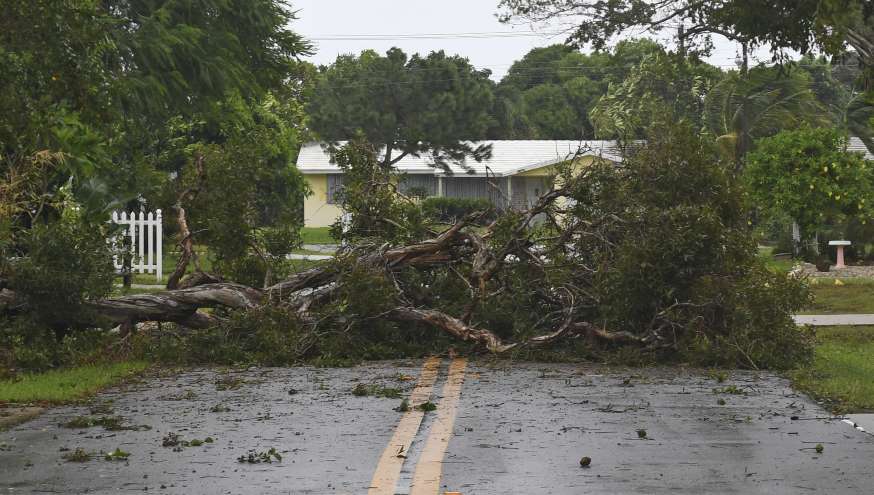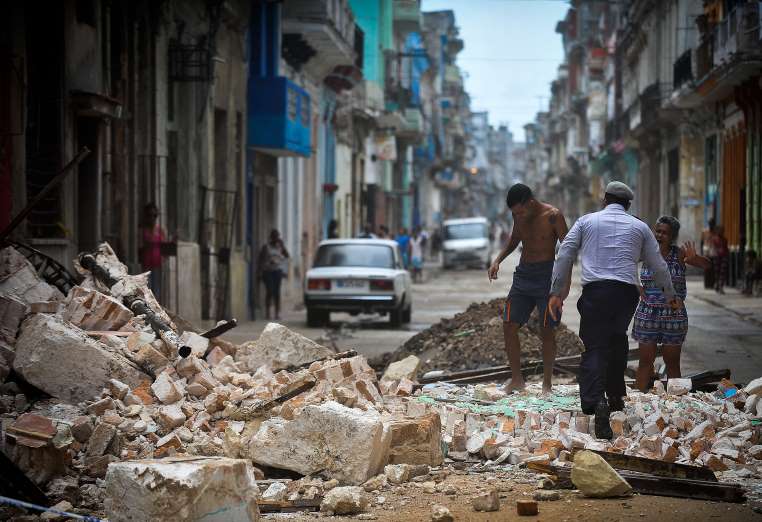September 10, 2017
MIAMI— A monster Hurricane Irma roared into Florida with 130 mph winds Sunday for what could be a sustained assault on nearly the entire Sunshine State, flooding streets, knocking out power to more than 1.5 million homes and businesses and snapping a construction crane over the Miami skyline.

September 10, 2017
MIAMI— A monster Hurricane Irma roared into Florida with 130 mph winds Sunday for what could be a sustained assault on nearly the entire Sunshine State, flooding streets, knocking out power to more than 1.5 million homes and businesses and snapping a construction crane over the Miami skyline.

A tree downed by Hurricane Irma blocks the road in Boynton Beach, Fla., Sunday, Sept. 10, 2017.
The nearly 400-mile-wide storm blew ashore in the morning in the Florida Keys and is expected to make a slow, ruinous march up the state's west coast, hitting the heavily populated Tampa-St. Petersburg area by Monday morning.
Streets emptied across the bottom half of the Florida peninsula and some 127,000 people huddled in shelters.
"Pray, pray for everybody in Florida," Gov. Rick Scott said on "Fox News Sunday."
Many streets were underwater in downtown Miami and in other cities. Roof damage and floating appliances and furniture were reported in the low-lying Keys, but with the storm still hitting around midday, the full extent of Irma's wrath was not clear.
A Miami woman who went into labor was guided through delivery by phone when authorities couldn't reach her in high winds and street flooding. Firefighters later took her to the hospital.
There were no immediate confirmed reports of any deaths in Florida, on top of 24 people killed during the storm's destructive trek across the Caribbean.

Cubans wade through the rubble from a collapsed building in Havana, on September 9, 2017. (Photo credit: YAMIL LAGE/AFP/Getty Images)
Irma's blast through the Cuban coastline weakened the storm to a Category Three, but it is still packing 125 mile-an-hour winds (205 kilometer per hour) and was expected to regain power before hitting the Florida Keys early Sunday, US forecasters said. The Cuban government extended its maximum state of alert to three additional provinces, including Havana, amid fears of flooding in low-lying areas.
While the projected track showed Irma raking the state's Gulf Coast, forecasters warned that the entire state — including the Miami metropolitan area of 6 million people — was in extreme peril because of the sheer size of the storm.
Nearly 7 million people in the Southeast were warned to evacuate, including 6.4 million in Florida alone.
About 30,000 people heeded orders to leave the Keys as the storm closed in, but an untold number refused, in part because to many storm-hardened residents, staying behind in the face of danger is a point of pride.
John Huston, who was riding out the storm at his Key Largo home, was already seeing flooding in his yard before the arrival of high tide. "Small boats floating down the street next to furniture and refrigerators. Very noisy," he said by text message. "Shingles are coming off."
In downtown Miami, one of two dozen construction cranes looming over the skyline broke with a loud crack atop a high-rise in Irma's winds. There was no immediate word on any damage or injuries. City officials said it would have taken about two weeks to move the cranes.
Irma made landfall just after 9 a.m. at Cudjoe Key, about 20 miles outside Key West, forecasters said. By late morning, it was advancing at about 9 mph toward Florida's southwestern corner, which includes Naples, Fort Myers and Sarasota.
For days, forecasters had warned that Irma was taking dead aim at the Miami metropolitan area and the rest of Florida's Atlantic coast.
But then Irma made a more pronounced westward shift — the result of what meteorologists said was an atmospheric tug-of-war between weather systems that nudged Irma and determined when it made its crucial right turn into Florida.
Meteorologist Ryan Maue of WeatherBell Analytics said the entire Florida peninsula will be raked by Irma's right front quadrant — the part of a hurricane that usually brings the strongest winds, storm surge, rain and tornadoes.
Even before the storm arrived, it made a huge swath of the peninsula's bottom half-unrecognizable.
Normally bustling streets were ghost towns. Party stretches including Duval Street in Key West and Ocean Drive in Miami Beach were shuttered. Sunday church services were called off, and theme parks were closed.
The Tampa-St. Petersburg area, with a population of about 3 million, has not taken a direct hit from a major hurricane since 1921. The wind was already picking up in St. Petersburg, some 400 miles north the Keys, and people began bracing for the onslaught.
"I've been here with other storms, other hurricanes. But this one scares me," Sally Carlson said she snapped photos of the waves crashing against boats. "Let's just say a prayer we hope we make it through."
The governor activated all 7,000 members of the Florida National Guard, and 10,000 guardsmen from elsewhere were being deployed.
Forecasters warned that after charting up Florida's west coast, a weakened Irma could push into Georgia, Alabama, Mississippi, Tennessee and beyond. A tropical storm warning was issued for the first time ever in Atlanta, some 200 miles from the sea.
"Once this system passes through, it's going to be a race to save lives and sustain lives," Federal Emergency Management Agency chief Brock Long said on "Fox News Sunday."
With FEMA still dealing with the aftermath of Hurricane Harvey in Houston, Irma could test the agency's ability to handle two disasters at the same time.
Florida Power and Light warned it will take weeks before electricity is fully restored.
Irma at one time was the most powerful hurricane ever recorded in the open Atlantic, with a peak wind speed of 185 mph (300 kph).
Given its mammoth size and strength and its projected course, Irma could prove one of the most devastating hurricanes ever to hit Florida.
The storm brought memories of Hurricane Charley in 2004, which blew ashore near Fort Myers with winds near 149 mph. It caused $15 billion in damage and was blamed for as many as 35 deaths in the U.S.
Courtesy/Source: AP
















































































































